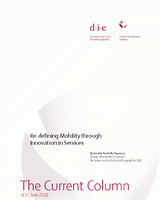Re-defining Mobility through Innovation in Services
Figueroa, AureliaThe Current Column (2013)
Bonn: German Development Institute / Deutsches Institut für Entwicklungspolitik (DIE) (The Current Column of 17 June 2013)
Bonn, 17 June 2013. Later this month, the Tour de France will be held for the one hundredth time. This marvel of mobility has hosted an increasing number of entrants and crossed greater and more diverse terrain over the years. Likewise, the number of people worldwide requiring transport, the distances they must travel, and the diversity of products and services they require has sped ahead. Innovations have contributed to ongoing improvements in the performance of Tour de France competitors. Transport services must likewise realise sustainable and inclusive innovations that better serve the increasing number of participants in the daily global mobility race.
A term used across disciplines with many different meanings, mobility describes, among other things, the ambulatory modes and capabilities of society. In the context of sustainable development and the post-2015 agenda, mobility must now be re-defined to simultaneously address carbon emissions and social inclusion. According to the International Energy Agency, the transport sector can account for up to 21% of carbon reductions. At the same time, access to transport must be scaled up to serve the estimated one billion people globally who lack access to affordable transport services.
The Sustainable Development Solutions Network (SDSN), of which the German Development Institute / Deutsches Institut für Entwicklungspolitik (DIE) is an active member, acknowledges in its report “An Action Agenda for Sustainable Development” access to transport and mobility as key elements of development and productivity. Innovation will be necessary to provide the necessary scale and scope of sustainable and inclusive mobility products and services and to achieve related pursuits of the post-2015 agenda. Behavioural change will likewise be necessary to adapt to these innovations and adopt more sustainable transit modes.
Mobility is transmutable. It is vital to understand the needs of transport consumers and the habits which shape their economic activities and social interactions. Whether it is riding a bike to work or taking a tuk-tuk to the marketplace, habits have been formed around transportation that shape economic and social conduct. While a cyclist can breeze past several kilometres of cars in metropolitan traffic jams in a fraction of the time, the more than one billion cars on Earth manifest in daily congestion from Lima to Lagos. A variety of concerns ranging from availability to safety prevent the realisation of sustainable and inclusive mobility. When solutions are forthcoming, there may often be trade-offs between inclusion and sustainability.
To meet growing and diverse demand, the scale of transport services offered must not only be increased, the scope must as well. Transport consumers need a range of options, whether it is a bike rental or an extended bus line reach the classroom more quickly. Adapted to the needs of society, sustainable and inclusive transport solutions maximise utility, contribute (in)directly to climate goals and facilitate economic development. Coherent policy frameworks, such as correctly pricing externalities can spur innovations to realise this.
In developing country megacities, both public transit services and private service provision provide important inputs to increasing mobility. While the expansion of inclusive public transit systems can present medium or long term sustainable mobility solutions, progress must also occur in the near term to increase transport options. Some examples from innovation in services and the sharing economy are relevant for near-term improvement.
Baby you can drive my car
The sharing economy has opened the use of mobility products to a broader array of people than just those capable of ownership by transforming a product into a service. This is exemplified in both developing and developed countries and has been operational for some time in other sectors, such as telecommunications.
Car sharing in the form of peer-to-peer and electric vehicle rentals is now underway from Paris to Pune and bike sharing is now found from Rio de Janeiro to Hangzhou. These innovative services which facilitate flexible use of transportation modes realise citizen-centric, intermodal solutions that provide the variety transport consumers need to efficiently ambulate. In a context of “sachet marketing”, a type of frugal innovation, the usage models offered through transportation sharing can enable mobility methods that would not otherwise be possible.
Assuming the risk of the car owner and renter by providing a service for payment, insurance, and roadside assistance, Buzzcar in France provides a peer-to-peer platform for car sharing. While there are mixed benefits and burdens to this, there are potential contributions to wellbeing and mobility by removing cars from the street while opening car use to a broader array of users than just those capable of car purchase. BuzzCar estimates that one well-shared car takes 15-20 off the street. Autolib’, a follow-up to the Parisian Velib’ bike sharing scheme, offers electric vehicles for rent at stations throughout the city. Electric vehicle rental is also found in emerging economies such as China and India.
Near term alternatives to long term lock-in
The innovative business models associated with the sharing economy may have been balked at before their implementation. Loaning a car to a random stranger for a fee? Renting an electric vehicle kerbside? These involve a reconsideration of notions of trust and risk and disrupt existing methods of mobility based upon ownership. In developing and developed countries alike, service innovations based on existing infrastructure, for example bike and car share, can contribute to achieving sustainable and inclusive mobility goals.
The sharing economy has facilitated à la carte mobility and provides examples of what near-term improvements may be made in a context of locked-in transportation infrastructure. Re-defining mobility involves major infrastructure improvements, to be sure. Yet, on the road to this future reality, innovations in transport service can and must be realised to provide ongoing improvements in inclusive and sustainable mobility.
This Current Column was drawn from experiences during a study trip with the Emerging Leaders in Energy and Environmental Policy (ELEEP) network.
